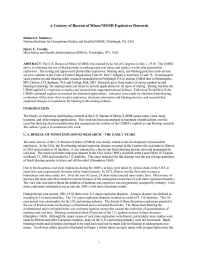Mining Publication: A Century of Bureau of Mines/NIOSH Explosives Research
Original creation date: March 2010
Authors: RJ Mainiero, HC Verakis
NIOSHTIC2 Number: 20036610
2010 SME Annual Meeting and Exhibit, February 28 - March 3, Phoenix, Arizona. Littleton, CO: Society for Mining, Metallurgy, and Exploration, Inc., 2010 Mar; :1-10
The U.S. Bureau of Mines (USBM) was created by an Act of Congress on July 1, 1910. The USBM strove to eliminate the use of black powder in underground coal mines and replace it with safer permissible explosives. The testing and approval of permissible explosives, blasting units, and blasting practices evolved and are now codified in the Code of Federal Regulations Title 30, Part 7, Subpart C and Parts 15 and 75. In subsequent years explosives and blasting safety research expanded from Pittsburgh, PA to include USBM labs in Minneapolis, MN, Denver, CO, Spokane, WA and College Park, MD. Research grew from studies of newer explosives and blasting technology for underground coal mines to include applications for all types of mining. During wartime the USBM applied it’s expertise to studies and research that supported national defense. Following World War II, the USBM continued explosives research for industrial applications. Advances were made on vibration from blasting, evaluations of the state-of-art in safer explosives, electronic detonators and blasting devices, and research that supported changes in regulations for blasting in the mining industry.

NIOSHTIC2 Number: 20036610
2010 SME Annual Meeting and Exhibit, February 28 - March 3, Phoenix, Arizona. Littleton, CO: Society for Mining, Metallurgy, and Exploration, Inc., 2010 Mar; :1-10
- Fatal Accidents Due to Flyrock and Lack of Blast Area Security and Working Practices in Mining
- A Gas Pressure-Based Drift Round Blast Design Methodology
- Low Temperature Limits for Mixing Recycled Oil, Diesel Fuel, and Ammonium Nitrate to Make ANFO-Type Blasting Agents
- Pressure Monitoring and Observed Effects of Mining at the Oak Grove, AL, Coalbed Degasification Pattern
- Safe Distances for Blasting Wiring from Commonly Encountered Underground Electromagnetic Energy Sources
- Secondary Explosion Hazards During Blasting in Oil Shale and Sulfide Ore Mines
- Short-Delay Blasting in Underground Coal Mines
- A Study of RF Hazards at Low and Medium Frequencies to Blasting in Underground Coal Mines
- Technology News 522 - Blast Area Security: Flyrock Safety
- Toolbox Training on Flyrock Awareness